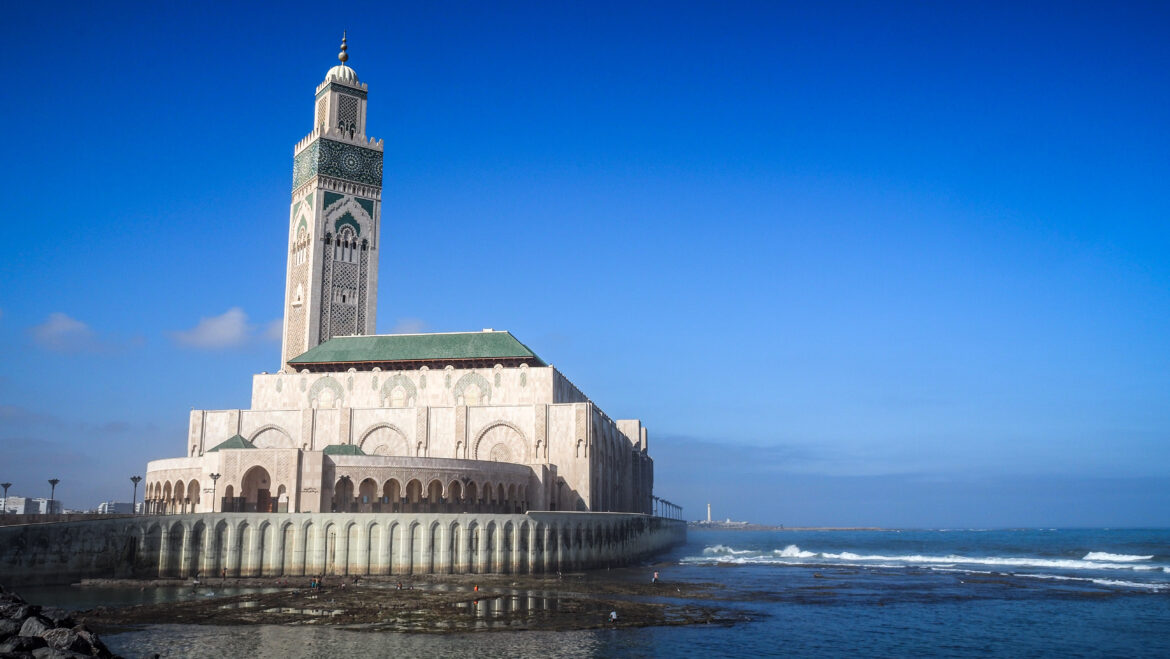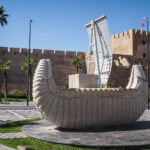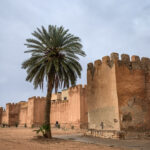Casablanca, now a bustling metropolis in Morocco, has a rich and varied history shaped by various cultures and influences over the centuries. The area around the town has been inhabited since at least the 7th century BC. The Berbers, the indigenous people of North Africa, were among the first to settle here.
The Phoenicians established a trading post in the region, followed by the Romans, who called it Anfa. By the 8th century, Anfa had become an important port for the Berber Kingdom of Barghawata.
In the 15th century, Portuguese traders and pirates frequently targeted Anfa. In 1468, the Portuguese destroyed the town due to its piracy issues.
In 1515, the Portuguese rebuilt the city and named it Casa Branca, meaning “White House.” They maintained control until the early 18th century and abandoned it following an earthquake and continued conflicts.
Sultan Mohammed ben Abdallah, from the Alaouite dynasty, rebuilt the city in the late 18th century, renaming it Dar el-Beida, which translates to “White House” in Arabic.
In 1912, Casablanca became part of the French Protectorate of Morocco. Under the French administration, the city underwent significant modernization and expansion, with new infrastructure, buildings, and a modern port.
After Morocco gained independence from France in 1956, Casablanca emerged as the country’s economic capital. The town also developed into a cultural centre, symbolizing modernity and progress in Morocco. The famous 1942 film “Casablanca,” though not filmed there, further romanticized the city in global popular culture.
Today, Casablanca is Morocco’s largest city and a key financial centre in Africa. It is home to iconic landmarks like the Hassan II Mosque, one of the largest mosques in the world, and the bustling Corniche seaside district. Unfortunately, the city has a bad reputation for being dirty and chaotic and all is true.
How to get there?
By Air:
Book a flight to Mohammed V International Airport (CMN), the primary airport serving Casablanca. Many major airlines offer direct flights from various global cities.
By Train:
If you’re already in Morocco, you can take a train from cities like Marrakech, Rabat, or Fes. Arrive at Casa Voyageurs or Casa Port, the main train station in Casablanca. ONCF, the national railway operator, provides regular and comfortable services.
By Bus:
Several bus companies, such as CTM and Supratours, offer routes to Casablanca from various Moroccan cities. Buses typically arrive at Gare Routière de Casablanca, from where you can take a taxi or local bus to your destination within the city.
By Car:
If you prefer driving, major highways like the A3 and A7 connect Casablanca with other Moroccan cities. You can rent a car from various international and local companies. Ensure you have a valid driver’s license and familiarize yourself with local driving laws.

The best time to visit
The best time to visit Casablanca is during the spring (April to June) and autumn (September to November) seasons. The temperatures are mild and pleasant, typically ranging from 15°C to 25°C. It’s a great time to explore the city’s attractions without the peak summer crowds.
During summer (July to August) Casablanca experiences warm weather with temperatures often exceeding 30°C. While it’s not as hot as inland Moroccan cities, the humidity can be high, making it less comfortable for sightseeing.
Winter (December to February) brings cooler weather with temperatures ranging from 8°C to 18°C. While it’s still a viable time to visit, some days may be rainy or windy.
Where to stay?
I stayed in Stayhere Casablanca – Gauthier 1 – Modern Residence which was nicely located near Arab League Park. The room and bathroom were clean but there were constant problems with electricity. The staff were really helpful and were doing their best to sort it out so I believe it won’t be an issue in the future.
How long to stay there?
Two full days are enough to discover the city comfortably and to take a long walk along the corniche. Casablanca is a very dirty and polluted city so you don’t want to stay there too long. Much better places in Morocco are awaiting your visit!
How to get around?
Casablanca has an efficient tramway system that connects different parts of the city. Petit taxis are an option for short distances within the city and grand taxis are for longer routes. Public buses are available too though it might be difficult to figure out the routes and schedules.
What to see in Casablanca?
Day 1
I left for sightseeing very early in the morning and it was nice to see the city waking up. Mohammed V Boulevard is one of the streets in town that has some fine examples of grand colonial-era buildings in Art Deco style, including the famous Cinema Rialto, which was completed in 1929 according to the designs of French architect Pierre Jabin.



After a quick breakfast in the form of croissant with coffee, I took a petit taxi to the biggest attraction in the city: Hassan II Mosque. Its history is deeply intertwined with the vision of King Hassan II, who sought to create a monument reflecting Morocco’s religious and cultural heritage while also making a statement on the global stage. The idea for the mosque was conceived in the 1980s.
The location chosen for the mosque was particularly significant. Perched on a promontory overlooking the Atlantic Ocean, the mosque would symbolize the connection between the heavens and the earth, a theme central to Islamic belief. Construction began in 1986 and was a massive undertaking, employing thousands of workers, artisans, and craftsmen from across Morocco. The project took seven years to complete, with the mosque finally being inaugurated on August 30, 1993, in time for the late king’s birthday celebrations.
The mosque’s construction was a point of national pride, and many Moroccans contributed to its funding through public donations. Architecturally, the Hassan II Mosque is a masterpiece that blends traditional Islamic design with modern engineering. The mosque’s design was the work of the French architect Michel Pinseau, who collaborated closely with Moroccan artisans to ensure that the structure reflected the country’s rich artistic heritage. The mosque features intricate mosaics, carved plaster, and woodwork, all executed with remarkable precision. One of the most striking aspects of the mosque is its minaret, which soars 210 meters into the sky, making it the tallest in the world. This minaret is equipped with a laser beam that points towards Mecca, a reminder of the direction in which Muslims pray.
The glass floor in some sections of the mosque allows worshippers to see the ocean waves beneath them, reinforcing the sense of connection between the earthly and the divine. The mosque is also equipped with modern amenities, including heated floors, retractable roofs, and sophisticated sound systems, ensuring comfort for the worshippers while preserving the sacred ambience. It can accommodate up to 105,000 worshippers, with space for 25,000 inside and 80,000 in the courtyard.
The guided tour lasts about an hour and is mandatory to participate if you want to visit the interior. It includes Prayer Hall, Minaret Hall and Ablution Hall. The cost is 130 MAD for foreigners. Working hours vary so it’s best to check them on the website HERE. Next to the ticket counter is also a small museum where you can kill time waiting for the guided tour to start.



From the mosque, you can take a long walk along the corniche towards Observation Deck Al Âank and El Hank Lighthouse. Stunning views of the city and the Atlantic Ocean are guaranteed. The lighthouse is also said to be one of the best places in Casablanca to see the sunset. It came into operation in 1920 and helped the development of the city of Casablanca, as it facilitated access to the port, which was previously considered dangerous. In October 2023 it was not possible to climb it but I have seen reports that it used to be open for tourists so you may want to check it out.
The walk can be continued along Boulevard de l’Océan Atlantique to beaches: Plage Lalla Meryem, Plage Aïn Diab and Plage Madame Choual. Then, take a petit taxi back to the centre of the town: United Nations Square. Constructed at the Medina’s entry during Morocco’s French Protectorate era, it currently serves as a vital hub for the city.
The place used to be occupied by Grand Souk, however, the city continued to expand after the French arrived in the early 20th century, permanently altering areas like this one. Thus, the clock tower was constructed in 1918 and the place was named Square of the Clock (later renamed Square of France). It marked the start of the city’s urban development, led by architect Henri Prost. The Excelsior Hotel and the Paris-Maroc department store are two examples of the new constructions that were erected in the square. The clock tower, which united the old and modern Casablanca, vanished in 1948 and was restored with a replica in 1993.
Nearby, across Rue Felix et Max Guedj is St John’s Church, the first Protestant church to be founded in Casablanca (1906). It was built on land owned by the British Crown and it is the oldest church building in the city.
The Medina Market is not as exciting as the ones in Marrakesh or Fes. This is still a traditional Moroccan medina, worth visiting if you don’t plan to go to other bigger cities, but apart from a couple of shops at its southern side, the neighbourhood is only a collection of somehow rundown residential buildings. Be careful about aggressive selling techniques and people promising to show you the way out. They will just lead you to their friend’s shop and ask for a tip.
Inside the walls of the Medina, there are also some interesting mosques, such as the Great Mosque, and the Ould el-Hamra Mosque (erected under Sultan Muhammad III bin Abdellah in 1789). There are some Jewish temples too. The Ettedgui Synagogue was bombarded by the Allies in November 1942 during the Naval Battle of Casablanca and the reconstruction started in 2011. The Beth-El Synagogue in the Jewish quarter is considered the centrepiece of a once vibrant Jewish community. It can be only visited if you are Jewish.
You might end the day at Rick’s Café, which is a restaurant, bar and cafe, opened in 2004 and designed to recreate the bar made famous by Humphrey Bogart and Ingrid Bergman in the movie classic Casablanca. Despite the title, the movie wasn’t filmed in Morocco but in Hollywood.
Day 2
I kicked off the day with a leisurely early morning walk in Arab League Park. Very well-maintained place with pathways lined with palm trees and neatly manicured bushes and plants. At the centre is a gorgeous fountain. Lots of space for people to stroll, jog, walk their dogs, and for children to play.

Near the park stands Sacred Heart Cathedral. Actually, it never was a cathedral, as Casablanca is not the seat of a bishopric. There was a sizeable Catholic community in town during the Protectorate times and French architect Paul Tournon designed the church in Art Deco style. Construction began in 1930 and finished in 1953. The country’s Catholic population began to fall three years later, in 1956, when Morocco achieved its independence. As a result, the edifice was no longer used as a church. Most probably you will only see it from the outside as it seems to be permanently closed for renovation.



Another place which is very close to the park is the Villa of Arts. It’s a cultural centre in a 1934 art deco villa, presenting contemporary art exhibitions and events. In my opinion, the building is more interesting than the art itself but of course, it’s a matter of taste 🙂
Mohammed V Square is one of the most lively places in town, especially on the weekends. You will see hundreds of pigeons hanging around (and as a result many objects covered in their shit) and locals feeding them. The square itself is surrounded by some magnificent buildings with traditional designs and rich history: Casablanca Court of First Instance, Poste Maroc and Bank Al-Maghrib.
Other buildings with interesting designs and facades, a bit further away from the square are Café La Princière, Hotel Amouday, Hotel Transatlantique and Hotel Volubilis.
Abderrahman Slaoui Foundation Museum bears the name of a Moroccan businessman and art collector who died in 2001. It showcases an amazing assortment of items, including vintage posters, crystal objects, Moroccan jewellery, Jacques Majorelle’s landscape paintings, Muhammad Ben Ali Rabati’s figurative paintings and much more.
Central Marketplace is an indoor hall built in the early 1900s, known for its selection of seafood. You will be approached by local sellers as soon as you enter it and each of them will do their best to drag you to the restaurant. Be careful as I heard that sometimes unwanted dishes appear on the table (e.g. salad) and the total amount of the bill can increase rapidly. If you notice such a manner, don’t touch the dish and strongly say that they should take it back.
Church of Notre Dame of Lourdes is a modernist Roman Catholic church, about 20 minutes walk from the Arab League Park. It was built in 1954 and the main attraction is the glasswork of world-famous stained glass artist Gabriel Loire.
Further away in the Habbous district, you will the Royal Palace. It’s not open to the public but you can’t see much from the street, other than entrance gates. It is regarded as Morocco’s second most famous royal location after the Royal Palace in Rabat and it has hosted important events. These include Hassan II’s meeting with Pope John Paul II in 1985, the first time a pope visited a Muslim nation at the invitation of an Islamic leader, and the fourth summit of the Organization of Islamic Cooperation in 1984.
Mahkama of Pacha is another interesting building to see in that area but watch out for scams. The place is apparently closed but the guards at the entrance tend to ask for about 100 MAD to let you in but it’s just a bribe and not an official ticket.
If you still have time and energy, visit the Museum of Moroccan Judaism. This institution is housed in a lovely garden home formerly used as a Jewish orphanage. It chronicles the 2000-year history of Jews in Morocco, with a focus on Casablanca’s Jewish community which was the biggest.
It is inconveniently located out of the main tourist zone so the best is the take a taxi to get there. The entrance fee is 50 MAD.



